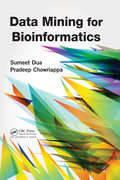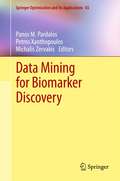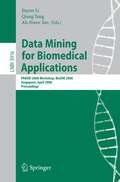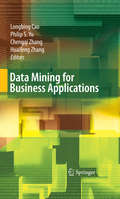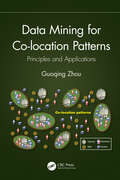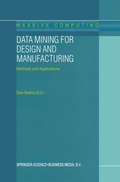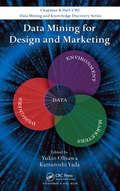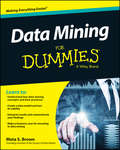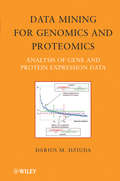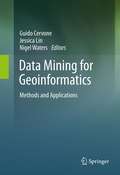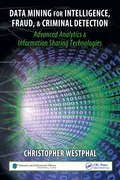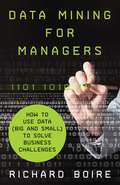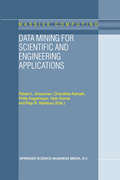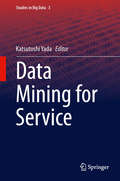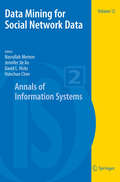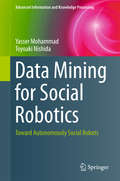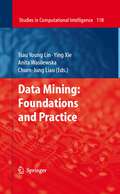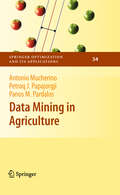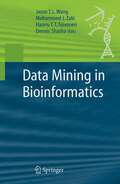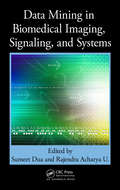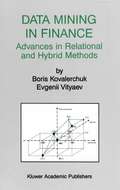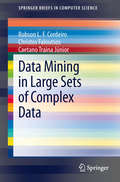- Table View
- List View
Data Mining for Bioinformatics
by Sumeet Dua Pradeep ChowriappaCovering theory, algorithms, and methodologies, as well as data mining technologies, Data Mining for Bioinformatics provides a comprehensive discussion of data-intensive computations used in data mining with applications in bioinformatics. It supplies a broad, yet in-depth, overview of the application domains of data mining for bioinformatics to he
Data Mining for Biomarker Discovery (Springer Optimization and Its Applications #65)
by Panos M. Pardalos Petros Xanthopoulos Michalis ZervakisBiomarker discovery is an important area of biomedical research that may lead to significant breakthroughs in disease analysis and targeted therapy. Biomarkers are biological entities whose alterations are measurable and are characteristic of a particular biological condition. Discovering, managing, and interpreting knowledge of new biomarkers are challenging and attractive problems in the emerging field of biomedical informatics.This volume is a collection of state-of-the-art research into the application of data mining to the discovery and analysis of new biomarkers. Presenting new results, models and algorithms, the included contributions focus on biomarker data integration, information retrieval methods, and statistical machine learning techniques.This volume is intended for students, and researchers in bioinformatics, proteomics, and genomics, as well engineers and applied scientists interested in the interdisciplinary application of data mining techniques.
Data Mining for Biomedical Applications: PAKDD 2006 Workshop, BioDM 2006, Singapore, April 9, 2006, Proceedings (Lecture Notes in Computer Science #3916)
by Jinyan Li Qiang Yang Ah-Hwee TanThis book constitutes the refereed proceedings of the International Workshop on Data Mining for Biomedical Applications, BioDM 2006, held in Singapore in conjunction with the 10th Pacific-Asia Conference on Knowledge Discovery and Data Mining (PAKDD 2006). The 14 revised full papers presented together with one keynote talk were carefully reviewed and selected from 35 submissions. The papers are organized in topical sections
Data Mining for Business Applications
by Longbing Cao Philip S. Yu Chengqi Zhang Huaifeng ZhangData Mining for Business Applications presents the state-of-the-art research and development outcomes on methodologies, techniques, approaches and successful applications in the area. The contributions mark a paradigm shift from “data-centered pattern mining” to “domain driven actionable knowledge discovery” for next-generation KDD research and applications. The contents identify how KDD techniques can better contribute to critical domain problems in theory and practice, and strengthen business intelligence in complex enterprise applications. The volume also explores challenges and directions for future research and development in the dialogue between academia and business.
Data Mining for Co-location Patterns: Principles and Applications
by Guoqing ZhouCo-location pattern mining detects sets of features frequently located in close proximity to each other. This book focuses on data mining for co-location pattern, a valid method for identifying patterns from all types of data and applying them in business intelligence and analytics. It explains the fundamentals of co-location pattern mining, co-location decision tree, and maximal instance co-location pattern mining along with an in-depth overview of data mining, machine learning, and statistics. This arrangement of chapters helps readers understand the methods of co-location pattern mining step-by-step and their applications in pavement management, image classification, geospatial buffer analysis, etc.
Data Mining for Co-location Patterns: Principles and Applications
by Guoqing ZhouCo-location pattern mining detects sets of features frequently located in close proximity to each other. This book focuses on data mining for co-location pattern, a valid method for identifying patterns from all types of data and applying them in business intelligence and analytics. It explains the fundamentals of co-location pattern mining, co-location decision tree, and maximal instance co-location pattern mining along with an in-depth overview of data mining, machine learning, and statistics. This arrangement of chapters helps readers understand the methods of co-location pattern mining step-by-step and their applications in pavement management, image classification, geospatial buffer analysis, etc.
Data Mining for Design and Manufacturing: Methods and Applications (Massive Computing #3)
by D. BrahaData Mining for Design and Manufacturing: Methods and Applications is the first book that brings together research and applications for data mining within design and manufacturing. The aim of the book is 1) to clarify the integration of data mining in engineering design and manufacturing, 2) to present a wide range of domains to which data mining can be applied, 3) to demonstrate the essential need for symbiotic collaboration of expertise in design and manufacturing, data mining, and information technology, and 4) to illustrate how to overcome central problems in design and manufacturing environments. The book also presents formal tools required to extract valuable information from design and manufacturing data, and facilitates interdisciplinary problem solving for enhanced decision making. Audience: The book is aimed at both academic and practising audiences. It can serve as a reference or textbook for senior or graduate level students in Engineering, Computer, and Management Sciences who are interested in data mining technologies. The book will be useful for practitioners interested in utilizing data mining techniques in design and manufacturing as well as for computer software developers engaged in developing data mining tools.
Data Mining for Design and Marketing
by Yukio Ohsawa Katsutoshi YadaData Mining for Design and Marketing shows how to design and integrate data mining tools into human thinking processes in order to make better business decisions, especially in designing and marketing products and systems.The expert contributors discuss how data mining can identify valuable consumer patterns, which aid marketers and designers in de
Data Mining For Dummies
by Meta S. BrownDelve into your data for the key to success Data mining is quickly becoming integral to creating value and business momentum. The ability to detect unseen patterns hidden in the numbers exhaustively generated by day-to-day operations allows savvy decision-makers to exploit every tool at their disposal in the pursuit of better business. By creating models and testing whether patterns hold up, it is possible to discover new intelligence that could change your business's entire paradigm for a more successful outcome. Data Mining for Dummies shows you why it doesn't take a data scientist to gain this advantage, and empowers average business people to start shaping a process relevant to their business's needs. In this book, you'll learn the hows and whys of mining to the depths of your data, and how to make the case for heavier investment into data mining capabilities. The book explains the details of the knowledge discovery process including: Model creation, validity testing, and interpretation Effective communication of findings Available tools, both paid and open-source Data selection, transformation, and evaluation Data Mining for Dummies takes you step-by-step through a real-world data-mining project using open-source tools that allow you to get immediate hands-on experience working with large amounts of data. You'll gain the confidence you need to start making data mining practices a routine part of your successful business. If you're serious about doing everything you can to push your company to the top, Data Mining for Dummies is your ticket to effective data mining.
Data Mining For Dummies
by Meta S. BrownDelve into your data for the key to success Data mining is quickly becoming integral to creating value and business momentum. The ability to detect unseen patterns hidden in the numbers exhaustively generated by day-to-day operations allows savvy decision-makers to exploit every tool at their disposal in the pursuit of better business. By creating models and testing whether patterns hold up, it is possible to discover new intelligence that could change your business's entire paradigm for a more successful outcome. Data Mining for Dummies shows you why it doesn't take a data scientist to gain this advantage, and empowers average business people to start shaping a process relevant to their business's needs. In this book, you'll learn the hows and whys of mining to the depths of your data, and how to make the case for heavier investment into data mining capabilities. The book explains the details of the knowledge discovery process including: Model creation, validity testing, and interpretation Effective communication of findings Available tools, both paid and open-source Data selection, transformation, and evaluation Data Mining for Dummies takes you step-by-step through a real-world data-mining project using open-source tools that allow you to get immediate hands-on experience working with large amounts of data. You'll gain the confidence you need to start making data mining practices a routine part of your successful business. If you're serious about doing everything you can to push your company to the top, Data Mining for Dummies is your ticket to effective data mining.
Data Mining for Genomics and Proteomics: Analysis of Gene and Protein Expression Data (Wiley Series on Methods and Applications in Data Mining #1)
by Darius M. DziudaData Mining for Genomics and Proteomics uses pragmatic examples and a complete case study to demonstrate step-by-step how biomedical studies can be used to maximize the chance of extracting new and useful biomedical knowledge from data. It is an excellent resource for students and professionals involved with gene or protein expression data in a variety of settings.
Data Mining for Geoinformatics: Methods and Applications
by Guido Cervone Jessica Lin Nigel WatersThe rate at which geospatial data is being generated exceeds our computational capabilities to extract patterns for the understanding of a dynamically changing world. Geoinformatics and data mining focuses on the development and implementation of computational algorithms to solve these problems. This unique volume contains a collection of chapters on state-of-the-art data mining techniques applied to geoinformatic problems of high complexity and important societal value. Data Mining for Geoinformatics addresses current concerns and developments relating to spatio-temporal data mining issues in remotely-sensed data, problems in meteorological data such as tornado formation, estimation of radiation from the Fukushima nuclear power plant, simulations of traffic data using OpenStreetMap, real time traffic applications of data stream mining, visual analytics of traffic and weather data and the exploratory visualization of collective, mobile objects such as the flocking behavior of wild chickens. This book is designed for researchers and advanced-level students focused on computer science, earth science and geography as a reference or secondary text book. Practitioners working in the areas of data mining and geoscience will also find this book to be a valuable reference.
Data Mining for Intelligence, Fraud & Criminal Detection: Advanced Analytics & Information Sharing Technologies
by Christopher WestphalIn 2004, the Government Accountability Office provided a report detailing approximately 200 government-based data-mining projects. While there is comfort in knowing that there are many effective systems, that comfort isn‘t worth much unless we can determine that these systems are being effectively and responsibly employed.Written by one of the most
Data Mining for Managers: How to Use Data (Big and Small) to Solve Business Challenges
by R. BoireBig Data is a growing business trend, but there little advice available on how to use it practically. Written by a data mining expert with over 30 years of experience, this book uses case studies to help marketers, brand managers and IT professionals understand how to capture and measure data for marketing purposes.
Data Mining for Scientific and Engineering Applications (Massive Computing #2)
by R. L. Grossman C. Kamath P. Kegelmeyer V. Kumar R. NamburuAdvances in technology are making massive data sets common in many scientific disciplines, such as astronomy, medical imaging, bio-informatics, combinatorial chemistry, remote sensing, and physics. To find useful information in these data sets, scientists and engineers are turning to data mining techniques. This book is a collection of papers based on the first two in a series of workshops on mining scientific datasets. It illustrates the diversity of problems and application areas that can benefit from data mining, as well as the issues and challenges that differentiate scientific data mining from its commercial counterpart. While the focus of the book is on mining scientific data, the work is of broader interest as many of the techniques can be applied equally well to data arising in business and web applications. Audience: This work would be an excellent text for students and researchers who are familiar with the basic principles of data mining and want to learn more about the application of data mining to their problem in science or engineering.
Data Mining for Service (Studies in Big Data #3)
by Katsutoshi YadaVirtually all nontrivial and modern service related problems and systems involve data volumes and types that clearly fall into what is presently meant as "big data", that is, are huge, heterogeneous, complex, distributed, etc.Data mining is a series of processes which include collecting and accumulating data, modeling phenomena, and discovering new information, and it is one of the most important steps to scientific analysis of the processes of services.Data mining application in services requires a thorough understanding of the characteristics of each service and knowledge of the compatibility of data mining technology within each particular service, rather than knowledge only in calculation speed and prediction accuracy. Varied examples of services provided in this book will help readers understand the relation between services and data mining technology. This book is intended to stimulate interest among researchers and practitioners in the relation between data mining technology and its application to other fields.
Data Mining for Social Network Data (Annals of Information Systems #12)
by Nasrullah Memon Jennifer Jie Xu David L. Hicks Hsinchun ChenDriven by counter-terrorism efforts, marketing analysis and an explosion in online social networking in recent years, data mining has moved to the forefront of information science. This proposed Special Issue on Data Mining for Social Network Data will present a broad range of recent studies in social networking analysis. It will focus on emerging trends and needs in discovery and analysis of communities, solitary and social activities, activities in open for a and commercial sites as well. It will also look at network modeling, infrastructure construction, dynamic growth and evolution pattern discovery using machine learning approaches and multi-agent based simulations. Editors are three rising stars in world of data mining, knowledge discovery, social network analysis, and information infrastructures, and are anchored by Springer author/editor Hsinchun Chen (Terrorism Informatics; Medical Informatics; Digital Government), who is one of the most prominent intelligence analysis and data mining experts in the world.
Data Mining for Social Robotics: Toward Autonomously Social Robots (Advanced Information and Knowledge Processing)
by Yasser Mohammad Toyoaki NishidaThis book explores an approach to social robotics based solely on autonomous unsupervised techniques and positions it within a structured exposition of related research in psychology, neuroscience, HRI, and data mining. The authors present an autonomous and developmental approach that allows the robot to learn interactive behavior by imitating humans using algorithms from time-series analysis and machine learning. The first part provides a comprehensive and structured introduction to time-series analysis, change point discovery, motif discovery and causality analysis focusing on possible applicability to HRI problems. Detailed explanations of all the algorithms involved are provided with open-source implementations in MATLAB enabling the reader to experiment with them. Imitation and simulation are the key technologies used to attain social behavior autonomously in the proposed approach. Part two gives the reader a wide overview of research in these areas in psychology, and ethology. Based on this background, the authors discuss approaches to endow robots with the ability to autonomously learn how to be social. Data Mining for Social Robots will be essential reading for graduate students and practitioners interested in social and developmental robotics.
Data Mining: Foundations and Practice (Studies in Computational Intelligence #118)
by Tsau Young Lin Ying Xie Anita Wasilewska Churn-Jung LiauThe IEEE ICDM 2004 workshop on the Foundation of Data Mining and the IEEE ICDM 2005 workshop on the Foundation of Semantic Oriented Data and Web Mining focused on topics ranging from the foundations of data mining to new data mining paradigms. The workshops brought together both data mining researchers and practitioners to discuss these two topics while seeking solutions to long standing data mining problems and stimul- ing new data mining research directions. We feel that the papers presented at these workshops may encourage the study of data mining as a scienti?c ?eld and spark new communications and collaborations between researchers and practitioners. Toexpressthevisionsforgedintheworkshopstoawiderangeofdatam- ing researchers and practitioners and foster active participation in the study of foundations of data mining, we edited this volume by involving extended and updated versions of selected papers presented at those workshops as well as some other relevant contributions. The content of this book includes st- ies of foundations of data mining from theoretical, practical, algorithmical, and managerial perspectives. The following is a brief summary of the papers contained in this book.
Data Mining in Agriculture (Springer Optimization and Its Applications #34)
by Antonio Mucherino Petraq Papajorgji Panos M. PardalosData Mining in Agriculture represents a comprehensive effort to provide graduate students and researchers with an analytical text on data mining techniques applied to agriculture and environmental related fields. This book presents both theoretical and practical insights with a focus on presenting the context of each data mining technique rather intuitively with ample concrete examples represented graphically and with algorithms written in MATLAB®.
Data Mining in Bioinformatics (Advanced Information and Knowledge Processing)
by Jason T. L. Wang Mohammed J. Zaki Hannu Toivonen Dennis ShashaWritten especially for computer scientists, all necessary biology is explained. Presents new techniques on gene expression data mining, gene mapping for disease detection, and phylogenetic knowledge discovery.
Data Mining in Biomedical Imaging, Signaling, and Systems
by Rajendra Acharya U Sumeet DuaData mining can help pinpoint hidden information in medical data and accurately differentiate pathological from normal data. It can help to extract hidden features from patient groups and disease states and can aid in automated decision making. Data Mining in Biomedical Imaging, Signaling, and Systems provides an in-depth examination of the biomedi
Data Mining in Biomedical Imaging, Signaling, and Systems
by Rajendra Acharya U Sumeet DuaData mining can help pinpoint hidden information in medical data and accurately differentiate pathological from normal data. It can help to extract hidden features from patient groups and disease states and can aid in automated decision making. Data Mining in Biomedical Imaging, Signaling, and Systems provides an in-depth examination of the biomedi
Data Mining in Finance: Advances in Relational and Hybrid Methods (The Springer International Series in Engineering and Computer Science #547)
by Boris Kovalerchuk Evgenii VityaevData Mining in Finance presents a comprehensive overview of major algorithmic approaches to predictive data mining, including statistical, neural networks, ruled-based, decision-tree, and fuzzy-logic methods, and then examines the suitability of these approaches to financial data mining. The book focuses specifically on relational data mining (RDM), which is a learning method able to learn more expressive rules than other symbolic approaches. RDM is thus better suited for financial mining, because it is able to make greater use of underlying domain knowledge. Relational data mining also has a better ability to explain the discovered rules - an ability critical for avoiding spurious patterns which inevitably arise when the number of variables examined is very large. The earlier algorithms for relational data mining, also known as inductive logic programming (ILP), suffer from a relative computational inefficiency and have rather limited tools for processing numerical data. Data Mining in Finance introduces a new approach, combining relational data mining with the analysis of statistical significance of discovered rules. This reduces the search space and speeds up the algorithms. The book also presents interactive and fuzzy-logic tools for `mining' the knowledge from the experts, further reducing the search space. Data Mining in Finance contains a number of practical examples of forecasting S&P 500, exchange rates, stock directions, and rating stocks for portfolio, allowing interested readers to start building their own models. This book is an excellent reference for researchers and professionals in the fields of artificial intelligence, machine learning, data mining, knowledge discovery, and applied mathematics.
Data Mining in Large Sets of Complex Data (SpringerBriefs in Computer Science)
by Robson Leonardo Ferreira Cordeiro Christos Faloutsos Caetano Traina JúniorThe amount and the complexity of the data gathered by current enterprises are increasing at an exponential rate. Consequently, the analysis of Big Data is nowadays a central challenge in Computer Science, especially for complex data. For example, given a satellite image database containing tens of Terabytes, how can we find regions aiming at identifying native rainforests, deforestation or reforestation? Can it be made automatically? Based on the work discussed in this book, the answers to both questions are a sound “yes”, and the results can be obtained in just minutes. In fact, results that used to require days or weeks of hard work from human specialists can now be obtained in minutes with high precision. Data Mining in Large Sets of Complex Data discusses new algorithms that take steps forward from traditional data mining (especially for clustering) by considering large, complex datasets. Usually, other works focus in one aspect, either data size or complexity. This work considers both: it enables mining complex data from high impact applications, such as breast cancer diagnosis, region classification in satellite images, assistance to climate change forecast, recommendation systems for the Web and social networks; the data are large in the Terabyte-scale, not in Giga as usual; and very accurate results are found in just minutes. Thus, it provides a crucial and well timed contribution for allowing the creation of real time applications that deal with Big Data of high complexity in which mining on the fly can make an immeasurable difference, such as supporting cancer diagnosis or detecting deforestation.
